
Windhoff motorcycles were built by Windhoff Motorradenbau GmbH in Berlin, Germany from 1924-1933. [1]

Windhoff motorcycles were built by Windhoff Motorradenbau GmbH in Berlin, Germany from 1924-1933. [1]
The factory was located at Bülowstrasse 106, Berlin W57, under the direction of factory owner Hans Windhoff. Windhoff initially produced radiators for cars, trucks, and aircraft, setting up a factory with his brother Fritz in Rheine in 1902, then on his own in Berlin from 1907-24. [2] In 1924, he entered the burgeoning German motorcycle market with a water-cooled two-stroke of 125cc. The engine was built under license from a design by Hugo Ruppe, whose ladepumpe (an extra piston used as a supercharger to compress the fuel/air mix) design was used most successfully by DKW in their Grand Prix racers. Windhoff had much racing success with these small two-strokes, although an experiment with enlarged two-stroke racers of 493cc and 517cc were less reliable. [3]
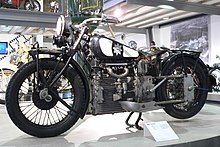
In 1926, a totally new machine was designed; a dramatic and technically fascinating 746cc overhead camshaft, oil-cooled 4-cylinder. Only Granville Bradshaw (creator of the ABC motorcycle) had successfully used an oil-cooled engine in a motorcycle. The engine, designed by Ing. Dauben (who later joined Mercedes on the W144 - W146 racers) had no external oilways, making a very clean design.
The engine finning acted as a giant radiator, with recirculating oil the cooling agent. The single overhead camshaft was driven by a train of gears at the front of the engine. Very few 4-cylinder production motorcycles of the pre-War period had an overhead camshaft (notable examples were the first iteration of the Ariel Square Four of 1931 and the Danish Nimbus of 1934). The 63x60mm short-stroke engine produced 22 hp at 4,000rpm, which gave an 80 mph+ top speed. The Windhoff chassis had no ‘frame’ to speak of, and the engine/gearbox unit was used as a stressed member, with the forks and rear subframe (4 parallel tubes) bolt directly onto it. The trailing-link forks use double leaf springs for damping, with no rear suspension; the rear frame tubes emerge straight out of the gearbox casting, and hold the final drive housing for the shaft drive, and rear hub and brake.
Despite its massive appearance, the total weight of the machine was only 440 lbs. The price when new was 1,750DM, a bit more than the contemporary 750cc BMW R63 (1,600DM).
Hans Windhoff designed a new machine for 1929, with a side valve flat-twin motor of 996cc, but the economic Crash of 1929 meant very few were produced. Windhoff struggled on with small two-stroke motorcycles of 298cc, with engines produced under license from Villiers. The company ceased operations by 1933.

Velocette is a line of motorcycles made by Veloce Ltd, in Hall Green, Birmingham, England. One of several motorcycle manufacturers in Birmingham, Velocette was a small, family-owned firm, selling almost as many hand-built motorcycles during its lifetime as the mass-produced machines of the giant BSA and Norton concerns. Renowned for the quality of its products, the company was "always in the picture" in international motorcycle racing from the mid-1920s until the 1950s, culminating in two World Championship titles and its legendary and still-unbeaten 24 hours at over 100 mph (161 km/h) record. Veloce, while small, was a great technical innovator and many of its patented designs are commonplace on motorcycles today, including the positive-stop foot shift and swinging arm rear suspension with hydraulic dampers. The business suffered a gradual commercial decline during the late 1960s, eventually closing in February 1971.
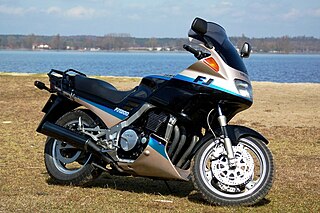
The Yamaha FJ1100 and FJ1200 are sport touring motorcycles that were produced by Yamaha between 1984 and 1996.
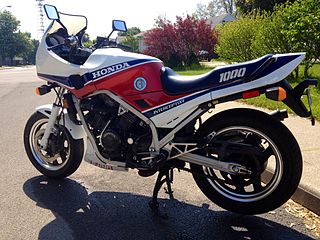
The VF1000 is a range of motorcycles produced by Honda from 1984 to 1988. The VF1000 is named after its V-4 998 cc (60.9 cu in) double overhead cam 16-valve engine. There were three main models in the VF1000 range, the VF1000F, the VF1000R and the VF1000F2.

A motorcycle engine is an engine that powers a motorcycle. Motorcycle engines are typically two-stroke or four-stroke internal combustion engines, but other engine types, such as Wankels and electric motors, have been used.

The L-twin is a naturally aspirated two-cylinder petrol engine by Ducati. It uses a 90-degree layout and 270-degree firing order and is mounted with one cylinder horizontal.

The Yamaha WR450F is an off-road motorcycle made by Yamaha Motor Company. It currently has a 450 cc (27 cu in) liquid-cooled single-cylinder engine. First offered in 1998 at 400cc, it shared many components and design concepts with the YZ400F motocross model. It is basically the racing YZ450F detuned slightly for more controllable power, with a headlight and lighting coil, softer suspension, a kickstand, lower noise specifications, larger radiators and lower emissions. The WR in the name indicates a wide-ratio gear box common to most enduro or trail bikes and stands in contrast to the close-ratio gearbox essential to a motocross racer. Over the years the WR has benefited from the advances made in the YZ motocross version gaining displacement and advancements such as an aluminum frame and improved suspension. Over much of its life the weight of the WR450F has remained fairly constant ranging from 244 to 249 pounds dry weight.

The Suzuki GSX-R400 was a 400 class sport bike produced by Japanese motorcycle manufacturer Suzuki between 1984 and 1996. It was the first GSX-R model ever made by Suzuki, as a race replica evolution of sport touring GSX series. Like other bikes in its class, the GSX-R400 was continuously updated and subsequently there is a slew of different models.
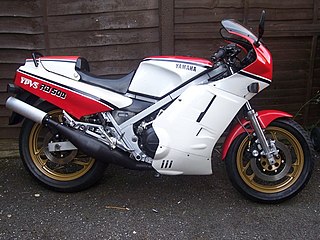
The Yamaha RD500LC is a high-performance, two-stroke sports motorcycle, also known as the RZ500 in Canada and Australia. A lightened but detuned version known as the RZV500R was developed for the Japanese home market. Strict United States Environmental Protection Agency regulations meant that the RZ500 was not available for sale in that country. Produced for a short period between 1984 and 1986 it has become a sought after collector's machine.

The Yamaha FZ750 is a sports motorcycle produced by Yamaha Motor Corporation between 1985 and 1991. The FZ750 is notable for several reasons, perhaps the most radical being the 5-valve cylinder head with a radial arrangement. This became something of a Yamaha trademark. The FZ750 would be the first bike in the Genesis design concept.

Tornax was a motorcycle manufacturer in Wuppertal, Germany.
BMW Motorrad is the motorcycle brand and division of German automotive manufacturer, BMW. It has produced motorcycles since 1923, and achieved record sales for the fifth year in succession in 2015. With a total of 136,963 vehicles sold in 2015, BMW registered a growth of 10.9% in sales in comparison with 2014. In May 2011, the 2,000,000th motorcycle produced by BMW Motorrad was an R1200GS.
The Hesketh V1000 is a 992 cc (60.5 cu in) OHC V-twin motorcycle with 4 valves per cylinder. It was originally designed and built by Hesketh Motorcycles in Daventry, Northamptonshire. Sales proved disappointing as the motorcycle was expensive and, at 86 bhp, it was somewhat underpowered given its hefty dry weight of 244 kg (538 lb).

The BSA A7 was a 500cc motorcycle model range made by Birmingham Small Arms Company (BSA) at its factory in Armoury Road, Small Heath, Birmingham. The range was launched in 1946 using a 495 cc (30.2 cu in) long stroke engine. An improved 497 cc (30.3 cu in) version based on the BSA A10 engine was launched in 1950. The various A7 models continued in production with minor modifications until 1961/2 when they were superseded by the unit-construction A50 model.

The BSA C15 was a 250 cc single-cylinder ohv motorcycle manufactured by the British company BSA from September 1958 until 1967, and was BSA's first four-stroke unit-construction bike. For most of that period, after the introduction of 'Learner Laws' in 1961, a 250 cc was the largest capacity solo machine that a learner could ride unaccompanied when displaying L-plates in the United Kingdom. A road-going Sports derivative was added in 1961, and off-road versions, for Trials and Scrambles, were also available in the range.
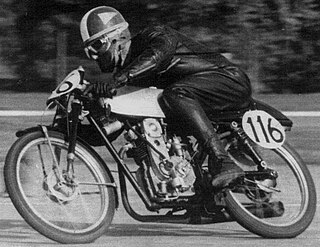
Tehuelche was an Argentine motorcycle that was produced between March 1957 and 1964.

The Honda VF750F is a street bike designed by Honda from 1983 to 1985. It has an 86 hp (64 kW), liquid-cooled, V4 engine which sports dual overhead cams (DOHC). The V4's were started a year before with the 1982 Honda Magna VF750C and Sabre VF750S but were adapted for the VF750F in 1983 by reducing the six speed transmission to a five speed because of the change from shaft drive to chain. This reduced the available space in the transmission thus changing to a five speed.

The MV Agusta 350 6 cilindri was a prototype racing motorcycle built by the Varese company MV Agusta in 1957, for the 350 cc class of the FIM Motorcycle World Championship. The project was resurrected in 1968. Neither version was ever used in a race. The only surviving model is now in the MV Agusta factory museum.

Bridgestone motorcycles were a division of the Bridgestone Tire Co. of Kyōbashi, Tokyo, Japan that produced mopeds and motorcycles from 1952 to 1970. Initially producing power assisted bicycles, the division moved on to producing mopeds and then motorcycles. The motorcycles were technologically advanced and powered by two-stroke engines. The high technical specification resulted in the machines being more expensive compared to other manufacturers models. Production was stopped in 1970 to protect the supply of tyres to other manufacturers.

The G450X is an Enduro-class motorcycle that was produced by BMW Motorrad between 2008 and 2011.
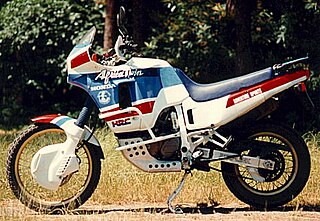
The XRV650 Africa Twin is an enduro motorcycle produced by the Japanese manufacturer Honda from 1988 to 1989. The enduro is derived from the design of the Honda XL600V Transalp and is powered by the V-twin cylinder engine of the Honda NT650 Hawk.
Notes